NURBN3021 Clinical Reflection: Airway Nursing Skills Assessment Report
VerifiedAdded on 2022/10/14
|9
|1917
|233
Report
AI Summary
This report presents a critical reflection on a student's experience as an airway nurse during a clinical skills assessment involving a simulated patient with shortness of breath. The student details their role, the scenario's context, and the nursing procedures performed, adhering to doctor's orders and nursing principles. The reflection delves into the student's emotional responses, including initial panic and anxiety, and evaluates the challenges faced, such as a faulty nebulizer. It analyzes the skills performed, like chest and respiratory assessments, and connects the practice to Jean Watson's theory of human caring, emphasizing patient-centered care. The report also examines current literature on resuscitation practices, highlighting best practices and changes in patient involvement and monitoring. The student concludes by acknowledging areas for improvement, such as chest sound assessment, and proposes an action plan involving further training, ethical considerations, and goal setting to enhance future performance and patient outcomes. The report is a comprehensive self-assessment of clinical skills and reflective practice.
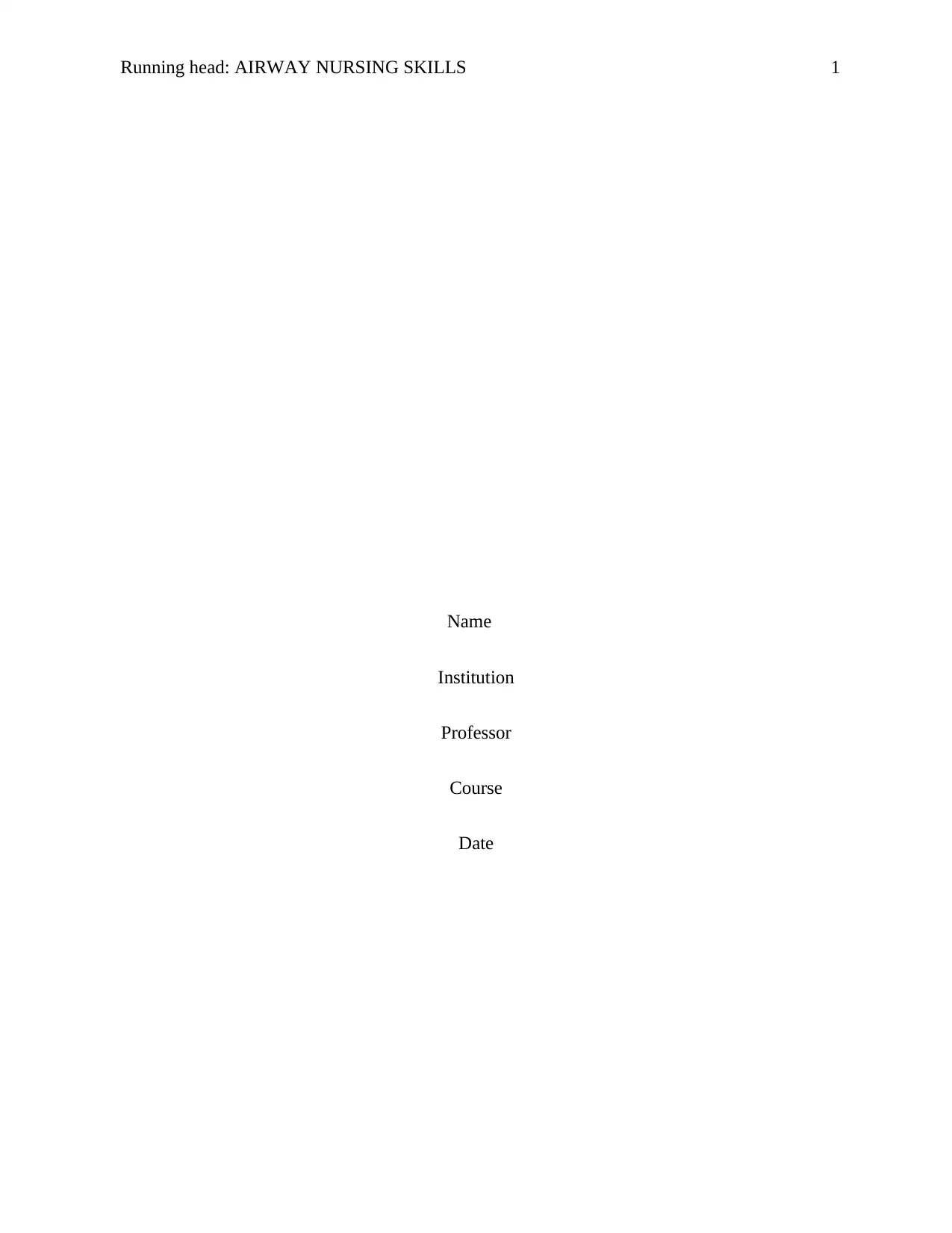
Running head: AIRWAY NURSING SKILLS 1
Name
Institution
Professor
Course
Date
Name
Institution
Professor
Course
Date
Paraphrase This Document
Need a fresh take? Get an instant paraphrase of this document with our AI Paraphraser
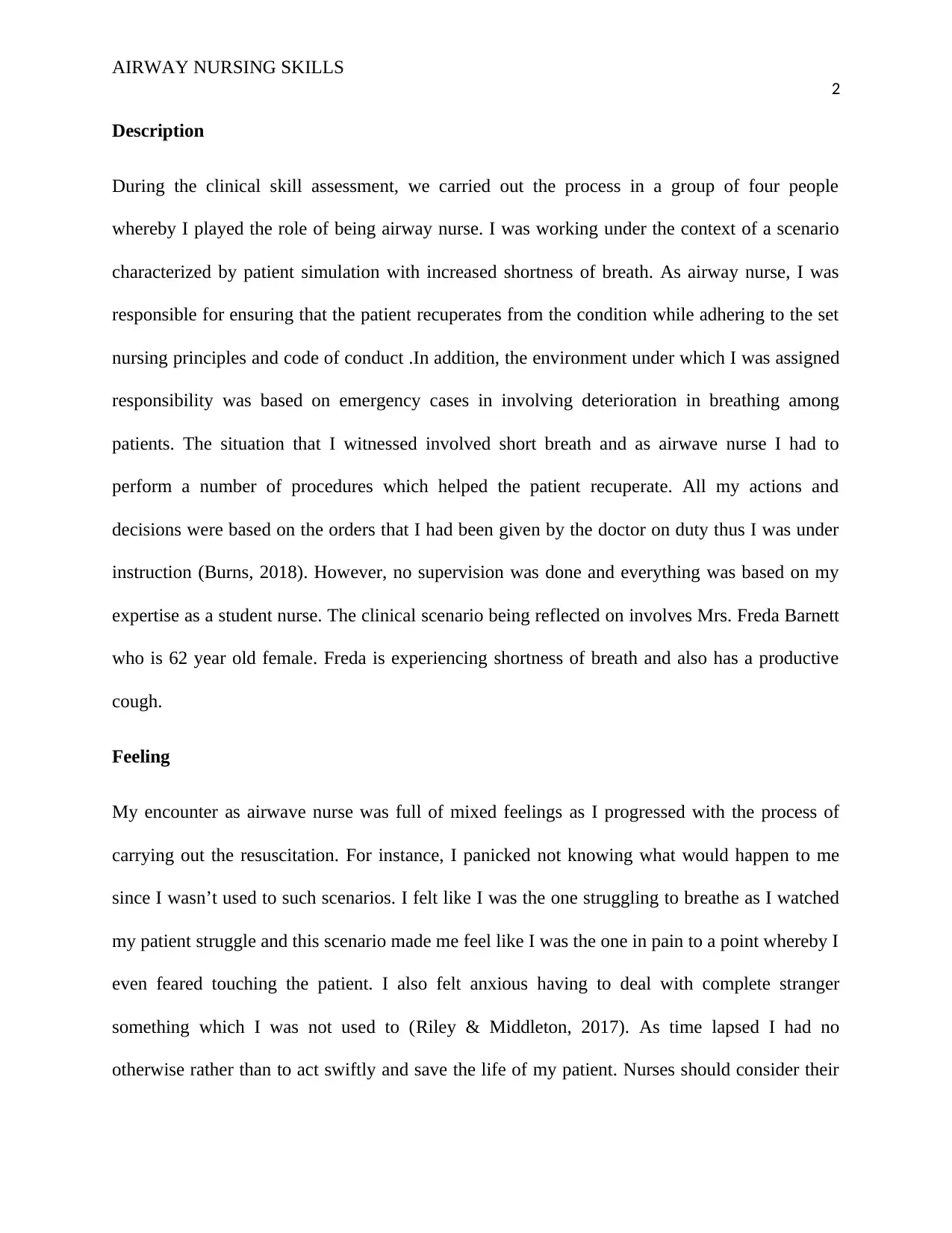
AIRWAY NURSING SKILLS
2
Description
During the clinical skill assessment, we carried out the process in a group of four people
whereby I played the role of being airway nurse. I was working under the context of a scenario
characterized by patient simulation with increased shortness of breath. As airway nurse, I was
responsible for ensuring that the patient recuperates from the condition while adhering to the set
nursing principles and code of conduct .In addition, the environment under which I was assigned
responsibility was based on emergency cases in involving deterioration in breathing among
patients. The situation that I witnessed involved short breath and as airwave nurse I had to
perform a number of procedures which helped the patient recuperate. All my actions and
decisions were based on the orders that I had been given by the doctor on duty thus I was under
instruction (Burns, 2018). However, no supervision was done and everything was based on my
expertise as a student nurse. The clinical scenario being reflected on involves Mrs. Freda Barnett
who is 62 year old female. Freda is experiencing shortness of breath and also has a productive
cough.
Feeling
My encounter as airwave nurse was full of mixed feelings as I progressed with the process of
carrying out the resuscitation. For instance, I panicked not knowing what would happen to me
since I wasn’t used to such scenarios. I felt like I was the one struggling to breathe as I watched
my patient struggle and this scenario made me feel like I was the one in pain to a point whereby I
even feared touching the patient. I also felt anxious having to deal with complete stranger
something which I was not used to (Riley & Middleton, 2017). As time lapsed I had no
otherwise rather than to act swiftly and save the life of my patient. Nurses should consider their
2
Description
During the clinical skill assessment, we carried out the process in a group of four people
whereby I played the role of being airway nurse. I was working under the context of a scenario
characterized by patient simulation with increased shortness of breath. As airway nurse, I was
responsible for ensuring that the patient recuperates from the condition while adhering to the set
nursing principles and code of conduct .In addition, the environment under which I was assigned
responsibility was based on emergency cases in involving deterioration in breathing among
patients. The situation that I witnessed involved short breath and as airwave nurse I had to
perform a number of procedures which helped the patient recuperate. All my actions and
decisions were based on the orders that I had been given by the doctor on duty thus I was under
instruction (Burns, 2018). However, no supervision was done and everything was based on my
expertise as a student nurse. The clinical scenario being reflected on involves Mrs. Freda Barnett
who is 62 year old female. Freda is experiencing shortness of breath and also has a productive
cough.
Feeling
My encounter as airwave nurse was full of mixed feelings as I progressed with the process of
carrying out the resuscitation. For instance, I panicked not knowing what would happen to me
since I wasn’t used to such scenarios. I felt like I was the one struggling to breathe as I watched
my patient struggle and this scenario made me feel like I was the one in pain to a point whereby I
even feared touching the patient. I also felt anxious having to deal with complete stranger
something which I was not used to (Riley & Middleton, 2017). As time lapsed I had no
otherwise rather than to act swiftly and save the life of my patient. Nurses should consider their
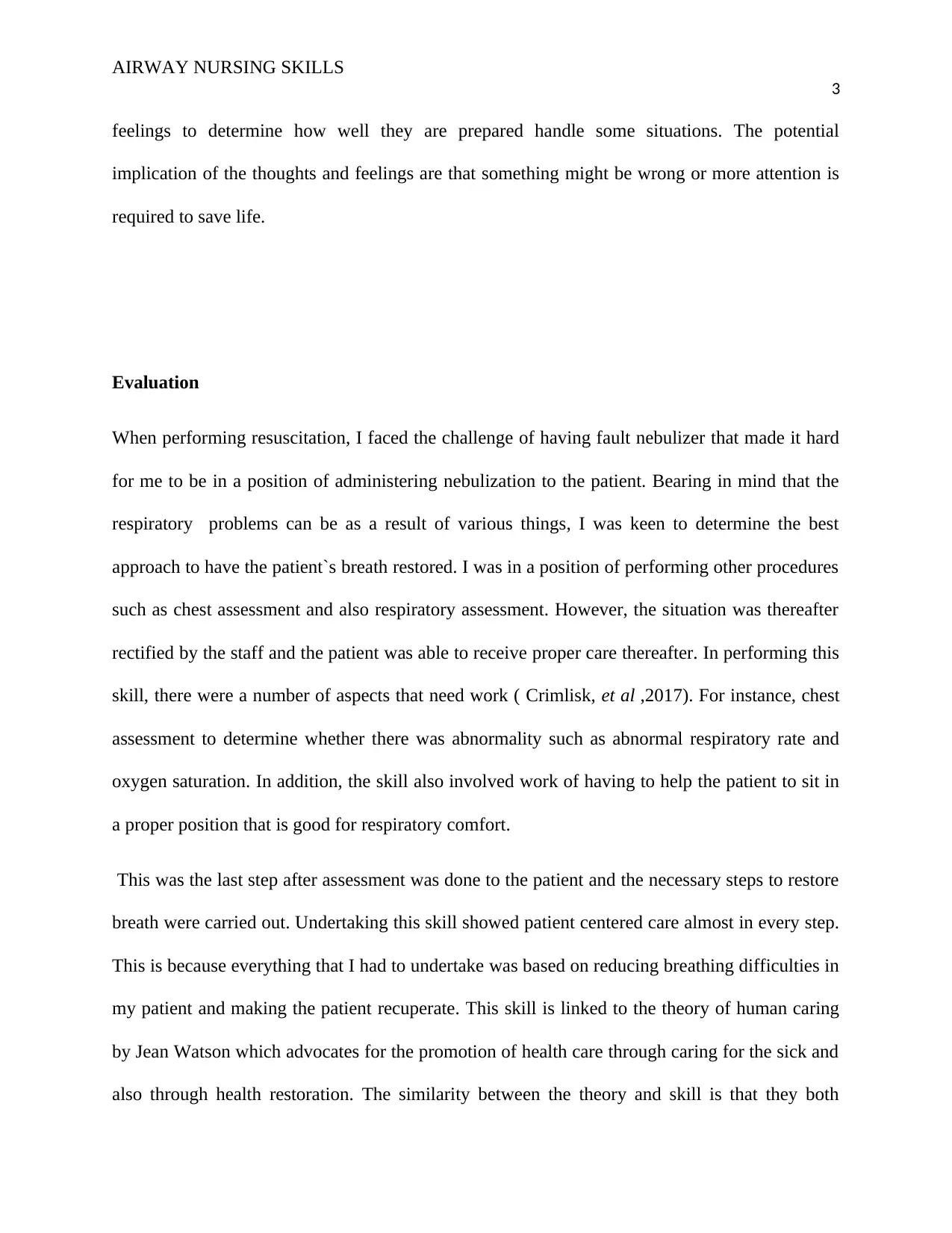
AIRWAY NURSING SKILLS
3
feelings to determine how well they are prepared handle some situations. The potential
implication of the thoughts and feelings are that something might be wrong or more attention is
required to save life.
Evaluation
When performing resuscitation, I faced the challenge of having fault nebulizer that made it hard
for me to be in a position of administering nebulization to the patient. Bearing in mind that the
respiratory problems can be as a result of various things, I was keen to determine the best
approach to have the patient`s breath restored. I was in a position of performing other procedures
such as chest assessment and also respiratory assessment. However, the situation was thereafter
rectified by the staff and the patient was able to receive proper care thereafter. In performing this
skill, there were a number of aspects that need work ( Crimlisk, et al ,2017). For instance, chest
assessment to determine whether there was abnormality such as abnormal respiratory rate and
oxygen saturation. In addition, the skill also involved work of having to help the patient to sit in
a proper position that is good for respiratory comfort.
This was the last step after assessment was done to the patient and the necessary steps to restore
breath were carried out. Undertaking this skill showed patient centered care almost in every step.
This is because everything that I had to undertake was based on reducing breathing difficulties in
my patient and making the patient recuperate. This skill is linked to the theory of human caring
by Jean Watson which advocates for the promotion of health care through caring for the sick and
also through health restoration. The similarity between the theory and skill is that they both
3
feelings to determine how well they are prepared handle some situations. The potential
implication of the thoughts and feelings are that something might be wrong or more attention is
required to save life.
Evaluation
When performing resuscitation, I faced the challenge of having fault nebulizer that made it hard
for me to be in a position of administering nebulization to the patient. Bearing in mind that the
respiratory problems can be as a result of various things, I was keen to determine the best
approach to have the patient`s breath restored. I was in a position of performing other procedures
such as chest assessment and also respiratory assessment. However, the situation was thereafter
rectified by the staff and the patient was able to receive proper care thereafter. In performing this
skill, there were a number of aspects that need work ( Crimlisk, et al ,2017). For instance, chest
assessment to determine whether there was abnormality such as abnormal respiratory rate and
oxygen saturation. In addition, the skill also involved work of having to help the patient to sit in
a proper position that is good for respiratory comfort.
This was the last step after assessment was done to the patient and the necessary steps to restore
breath were carried out. Undertaking this skill showed patient centered care almost in every step.
This is because everything that I had to undertake was based on reducing breathing difficulties in
my patient and making the patient recuperate. This skill is linked to the theory of human caring
by Jean Watson which advocates for the promotion of health care through caring for the sick and
also through health restoration. The similarity between the theory and skill is that they both
⊘ This is a preview!⊘
Do you want full access?
Subscribe today to unlock all pages.

Trusted by 1+ million students worldwide
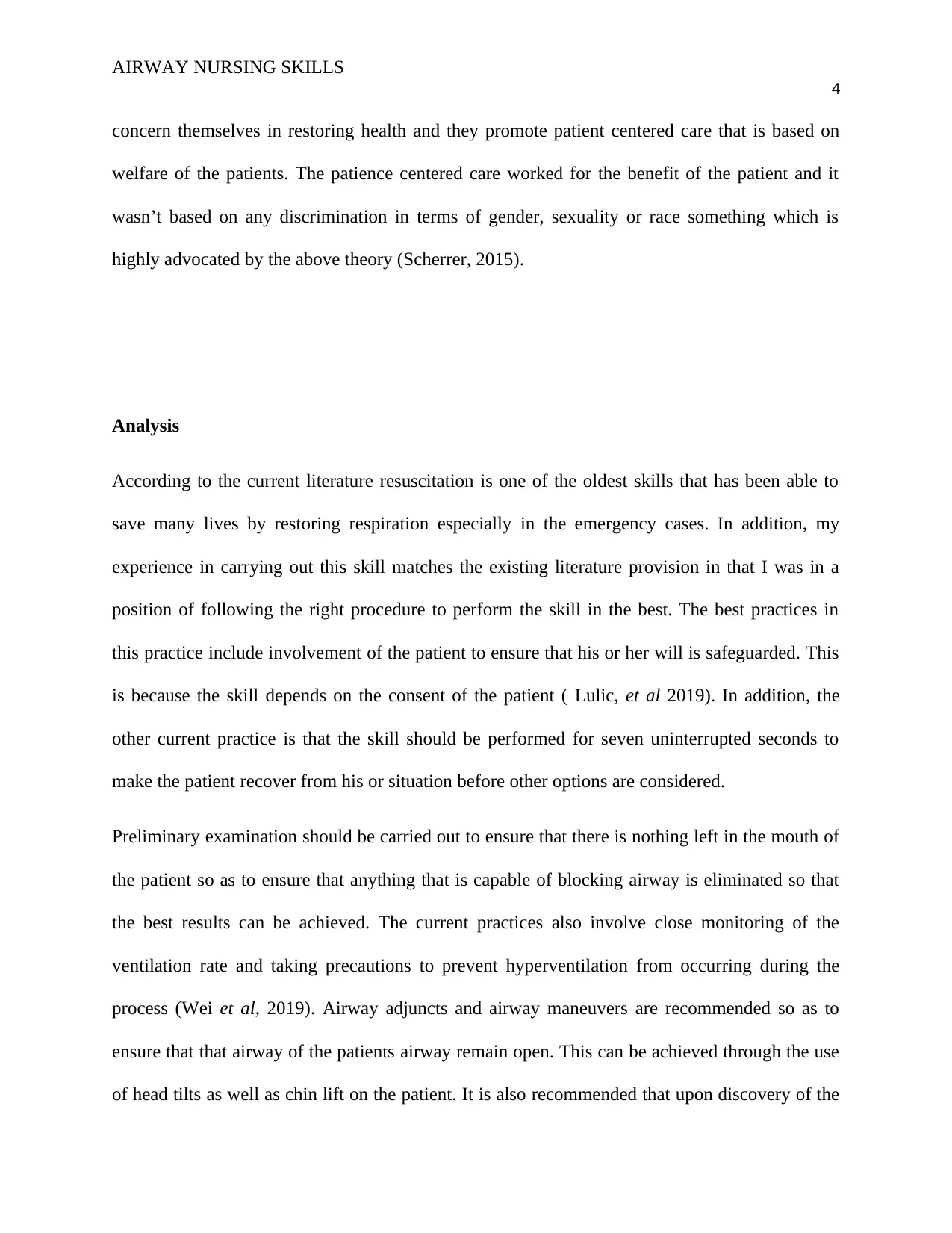
AIRWAY NURSING SKILLS
4
concern themselves in restoring health and they promote patient centered care that is based on
welfare of the patients. The patience centered care worked for the benefit of the patient and it
wasn’t based on any discrimination in terms of gender, sexuality or race something which is
highly advocated by the above theory (Scherrer, 2015).
Analysis
According to the current literature resuscitation is one of the oldest skills that has been able to
save many lives by restoring respiration especially in the emergency cases. In addition, my
experience in carrying out this skill matches the existing literature provision in that I was in a
position of following the right procedure to perform the skill in the best. The best practices in
this practice include involvement of the patient to ensure that his or her will is safeguarded. This
is because the skill depends on the consent of the patient ( Lulic, et al 2019). In addition, the
other current practice is that the skill should be performed for seven uninterrupted seconds to
make the patient recover from his or situation before other options are considered.
Preliminary examination should be carried out to ensure that there is nothing left in the mouth of
the patient so as to ensure that anything that is capable of blocking airway is eliminated so that
the best results can be achieved. The current practices also involve close monitoring of the
ventilation rate and taking precautions to prevent hyperventilation from occurring during the
process (Wei et al, 2019). Airway adjuncts and airway maneuvers are recommended so as to
ensure that that airway of the patients airway remain open. This can be achieved through the use
of head tilts as well as chin lift on the patient. It is also recommended that upon discovery of the
4
concern themselves in restoring health and they promote patient centered care that is based on
welfare of the patients. The patience centered care worked for the benefit of the patient and it
wasn’t based on any discrimination in terms of gender, sexuality or race something which is
highly advocated by the above theory (Scherrer, 2015).
Analysis
According to the current literature resuscitation is one of the oldest skills that has been able to
save many lives by restoring respiration especially in the emergency cases. In addition, my
experience in carrying out this skill matches the existing literature provision in that I was in a
position of following the right procedure to perform the skill in the best. The best practices in
this practice include involvement of the patient to ensure that his or her will is safeguarded. This
is because the skill depends on the consent of the patient ( Lulic, et al 2019). In addition, the
other current practice is that the skill should be performed for seven uninterrupted seconds to
make the patient recover from his or situation before other options are considered.
Preliminary examination should be carried out to ensure that there is nothing left in the mouth of
the patient so as to ensure that anything that is capable of blocking airway is eliminated so that
the best results can be achieved. The current practices also involve close monitoring of the
ventilation rate and taking precautions to prevent hyperventilation from occurring during the
process (Wei et al, 2019). Airway adjuncts and airway maneuvers are recommended so as to
ensure that that airway of the patients airway remain open. This can be achieved through the use
of head tilts as well as chin lift on the patient. It is also recommended that upon discovery of the
Paraphrase This Document
Need a fresh take? Get an instant paraphrase of this document with our AI Paraphraser
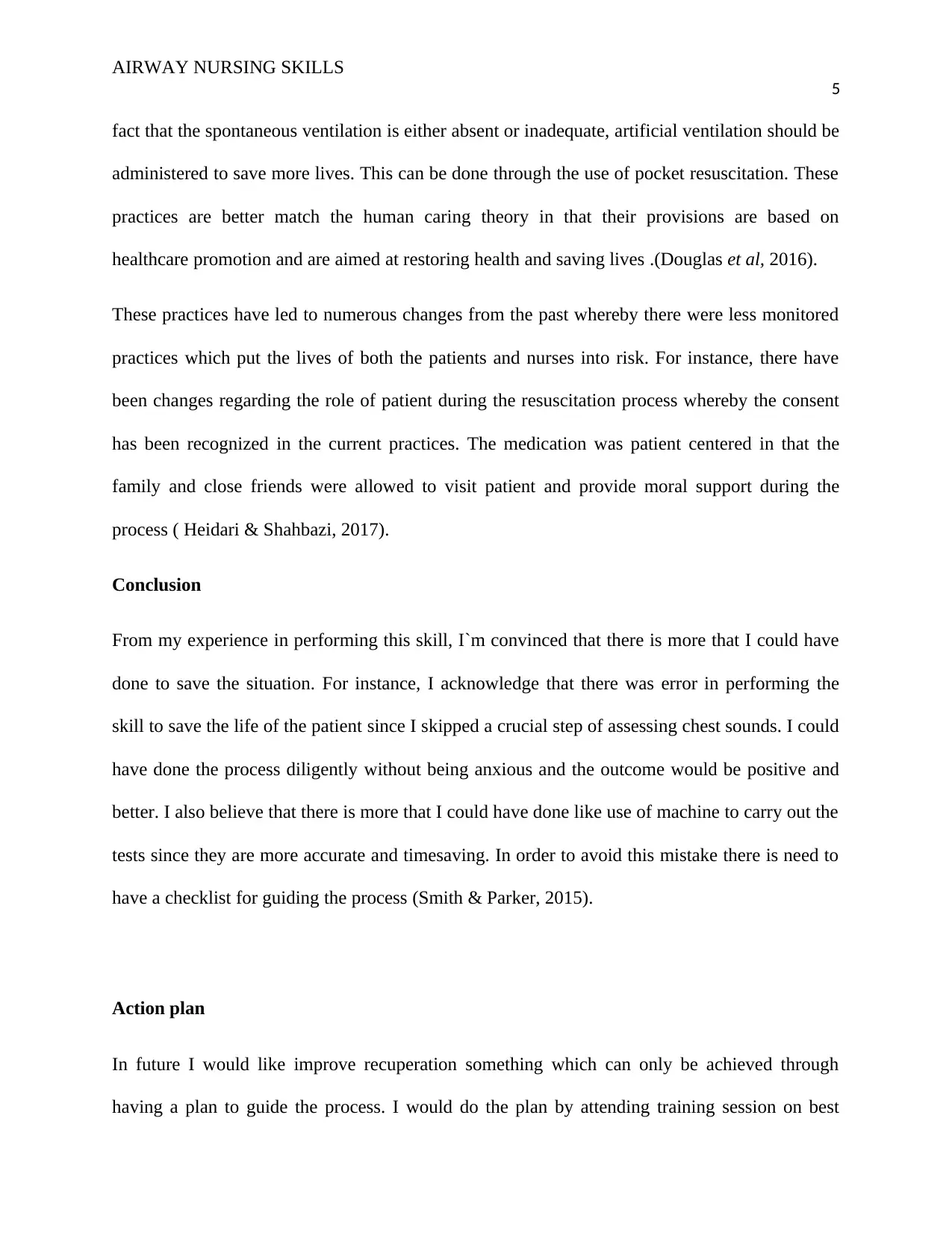
AIRWAY NURSING SKILLS
5
fact that the spontaneous ventilation is either absent or inadequate, artificial ventilation should be
administered to save more lives. This can be done through the use of pocket resuscitation. These
practices are better match the human caring theory in that their provisions are based on
healthcare promotion and are aimed at restoring health and saving lives .(Douglas et al, 2016).
These practices have led to numerous changes from the past whereby there were less monitored
practices which put the lives of both the patients and nurses into risk. For instance, there have
been changes regarding the role of patient during the resuscitation process whereby the consent
has been recognized in the current practices. The medication was patient centered in that the
family and close friends were allowed to visit patient and provide moral support during the
process ( Heidari & Shahbazi, 2017).
Conclusion
From my experience in performing this skill, I`m convinced that there is more that I could have
done to save the situation. For instance, I acknowledge that there was error in performing the
skill to save the life of the patient since I skipped a crucial step of assessing chest sounds. I could
have done the process diligently without being anxious and the outcome would be positive and
better. I also believe that there is more that I could have done like use of machine to carry out the
tests since they are more accurate and timesaving. In order to avoid this mistake there is need to
have a checklist for guiding the process (Smith & Parker, 2015).
Action plan
In future I would like improve recuperation something which can only be achieved through
having a plan to guide the process. I would do the plan by attending training session on best
5
fact that the spontaneous ventilation is either absent or inadequate, artificial ventilation should be
administered to save more lives. This can be done through the use of pocket resuscitation. These
practices are better match the human caring theory in that their provisions are based on
healthcare promotion and are aimed at restoring health and saving lives .(Douglas et al, 2016).
These practices have led to numerous changes from the past whereby there were less monitored
practices which put the lives of both the patients and nurses into risk. For instance, there have
been changes regarding the role of patient during the resuscitation process whereby the consent
has been recognized in the current practices. The medication was patient centered in that the
family and close friends were allowed to visit patient and provide moral support during the
process ( Heidari & Shahbazi, 2017).
Conclusion
From my experience in performing this skill, I`m convinced that there is more that I could have
done to save the situation. For instance, I acknowledge that there was error in performing the
skill to save the life of the patient since I skipped a crucial step of assessing chest sounds. I could
have done the process diligently without being anxious and the outcome would be positive and
better. I also believe that there is more that I could have done like use of machine to carry out the
tests since they are more accurate and timesaving. In order to avoid this mistake there is need to
have a checklist for guiding the process (Smith & Parker, 2015).
Action plan
In future I would like improve recuperation something which can only be achieved through
having a plan to guide the process. I would do the plan by attending training session on best
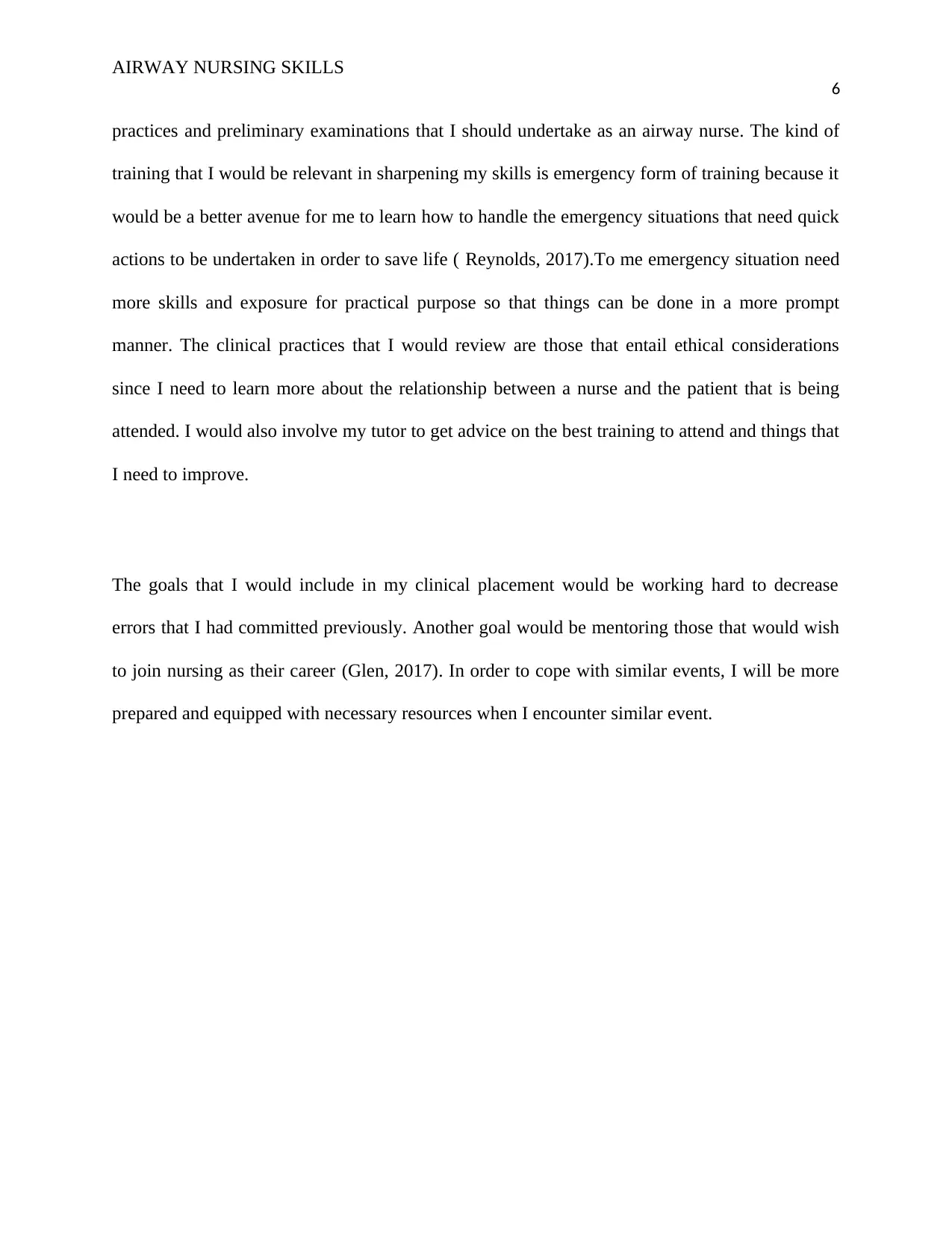
AIRWAY NURSING SKILLS
6
practices and preliminary examinations that I should undertake as an airway nurse. The kind of
training that I would be relevant in sharpening my skills is emergency form of training because it
would be a better avenue for me to learn how to handle the emergency situations that need quick
actions to be undertaken in order to save life ( Reynolds, 2017).To me emergency situation need
more skills and exposure for practical purpose so that things can be done in a more prompt
manner. The clinical practices that I would review are those that entail ethical considerations
since I need to learn more about the relationship between a nurse and the patient that is being
attended. I would also involve my tutor to get advice on the best training to attend and things that
I need to improve.
The goals that I would include in my clinical placement would be working hard to decrease
errors that I had committed previously. Another goal would be mentoring those that would wish
to join nursing as their career (Glen, 2017). In order to cope with similar events, I will be more
prepared and equipped with necessary resources when I encounter similar event.
6
practices and preliminary examinations that I should undertake as an airway nurse. The kind of
training that I would be relevant in sharpening my skills is emergency form of training because it
would be a better avenue for me to learn how to handle the emergency situations that need quick
actions to be undertaken in order to save life ( Reynolds, 2017).To me emergency situation need
more skills and exposure for practical purpose so that things can be done in a more prompt
manner. The clinical practices that I would review are those that entail ethical considerations
since I need to learn more about the relationship between a nurse and the patient that is being
attended. I would also involve my tutor to get advice on the best training to attend and things that
I need to improve.
The goals that I would include in my clinical placement would be working hard to decrease
errors that I had committed previously. Another goal would be mentoring those that would wish
to join nursing as their career (Glen, 2017). In order to cope with similar events, I will be more
prepared and equipped with necessary resources when I encounter similar event.
⊘ This is a preview!⊘
Do you want full access?
Subscribe today to unlock all pages.

Trusted by 1+ million students worldwide
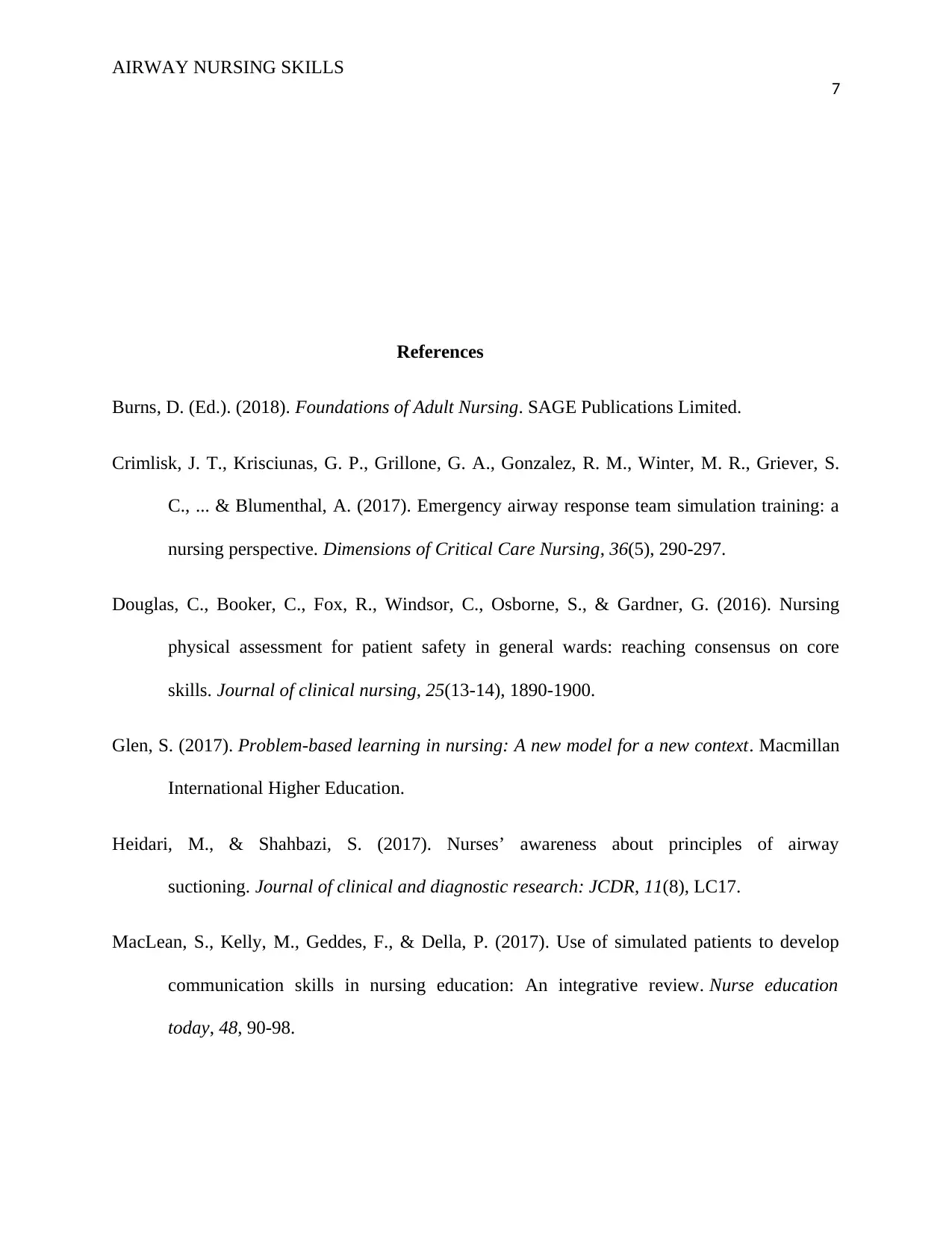
AIRWAY NURSING SKILLS
7
References
Burns, D. (Ed.). (2018). Foundations of Adult Nursing. SAGE Publications Limited.
Crimlisk, J. T., Krisciunas, G. P., Grillone, G. A., Gonzalez, R. M., Winter, M. R., Griever, S.
C., ... & Blumenthal, A. (2017). Emergency airway response team simulation training: a
nursing perspective. Dimensions of Critical Care Nursing, 36(5), 290-297.
Douglas, C., Booker, C., Fox, R., Windsor, C., Osborne, S., & Gardner, G. (2016). Nursing
physical assessment for patient safety in general wards: reaching consensus on core
skills. Journal of clinical nursing, 25(13-14), 1890-1900.
Glen, S. (2017). Problem-based learning in nursing: A new model for a new context. Macmillan
International Higher Education.
Heidari, M., & Shahbazi, S. (2017). Nurses’ awareness about principles of airway
suctioning. Journal of clinical and diagnostic research: JCDR, 11(8), LC17.
MacLean, S., Kelly, M., Geddes, F., & Della, P. (2017). Use of simulated patients to develop
communication skills in nursing education: An integrative review. Nurse education
today, 48, 90-98.
7
References
Burns, D. (Ed.). (2018). Foundations of Adult Nursing. SAGE Publications Limited.
Crimlisk, J. T., Krisciunas, G. P., Grillone, G. A., Gonzalez, R. M., Winter, M. R., Griever, S.
C., ... & Blumenthal, A. (2017). Emergency airway response team simulation training: a
nursing perspective. Dimensions of Critical Care Nursing, 36(5), 290-297.
Douglas, C., Booker, C., Fox, R., Windsor, C., Osborne, S., & Gardner, G. (2016). Nursing
physical assessment for patient safety in general wards: reaching consensus on core
skills. Journal of clinical nursing, 25(13-14), 1890-1900.
Glen, S. (2017). Problem-based learning in nursing: A new model for a new context. Macmillan
International Higher Education.
Heidari, M., & Shahbazi, S. (2017). Nurses’ awareness about principles of airway
suctioning. Journal of clinical and diagnostic research: JCDR, 11(8), LC17.
MacLean, S., Kelly, M., Geddes, F., & Della, P. (2017). Use of simulated patients to develop
communication skills in nursing education: An integrative review. Nurse education
today, 48, 90-98.
Paraphrase This Document
Need a fresh take? Get an instant paraphrase of this document with our AI Paraphraser
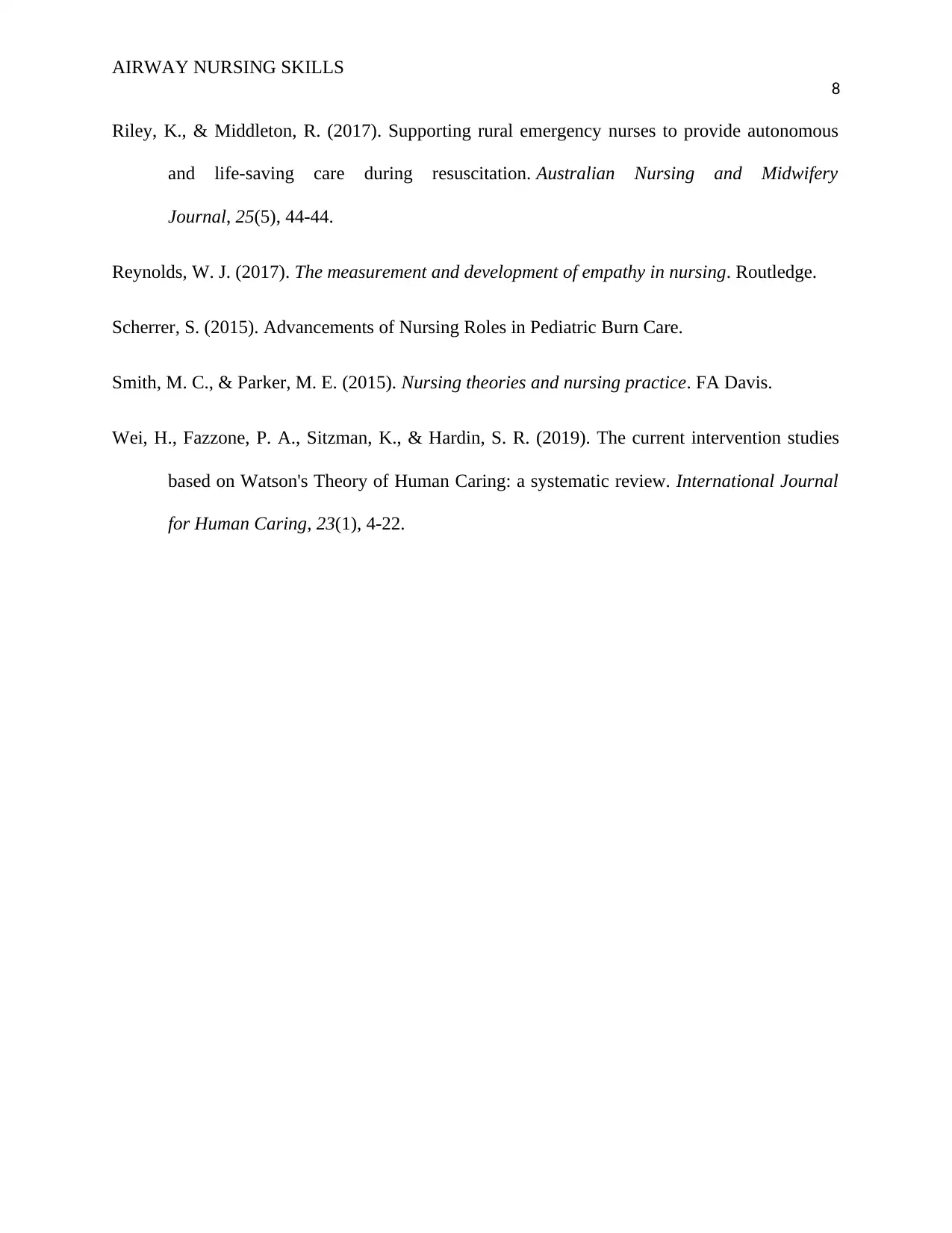
AIRWAY NURSING SKILLS
8
Riley, K., & Middleton, R. (2017). Supporting rural emergency nurses to provide autonomous
and life-saving care during resuscitation. Australian Nursing and Midwifery
Journal, 25(5), 44-44.
Reynolds, W. J. (2017). The measurement and development of empathy in nursing. Routledge.
Scherrer, S. (2015). Advancements of Nursing Roles in Pediatric Burn Care.
Smith, M. C., & Parker, M. E. (2015). Nursing theories and nursing practice. FA Davis.
Wei, H., Fazzone, P. A., Sitzman, K., & Hardin, S. R. (2019). The current intervention studies
based on Watson's Theory of Human Caring: a systematic review. International Journal
for Human Caring, 23(1), 4-22.
8
Riley, K., & Middleton, R. (2017). Supporting rural emergency nurses to provide autonomous
and life-saving care during resuscitation. Australian Nursing and Midwifery
Journal, 25(5), 44-44.
Reynolds, W. J. (2017). The measurement and development of empathy in nursing. Routledge.
Scherrer, S. (2015). Advancements of Nursing Roles in Pediatric Burn Care.
Smith, M. C., & Parker, M. E. (2015). Nursing theories and nursing practice. FA Davis.
Wei, H., Fazzone, P. A., Sitzman, K., & Hardin, S. R. (2019). The current intervention studies
based on Watson's Theory of Human Caring: a systematic review. International Journal
for Human Caring, 23(1), 4-22.

AIRWAY NURSING SKILLS
9
9
⊘ This is a preview!⊘
Do you want full access?
Subscribe today to unlock all pages.

Trusted by 1+ million students worldwide
1 out of 9
Related Documents
Your All-in-One AI-Powered Toolkit for Academic Success.
+13062052269
info@desklib.com
Available 24*7 on WhatsApp / Email
![[object Object]](/_next/static/media/star-bottom.7253800d.svg)
Unlock your academic potential
Copyright © 2020–2025 A2Z Services. All Rights Reserved. Developed and managed by ZUCOL.





